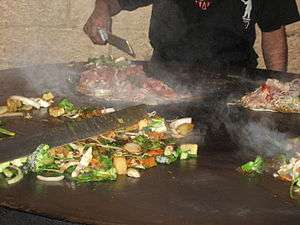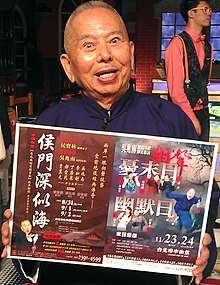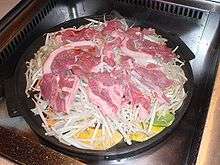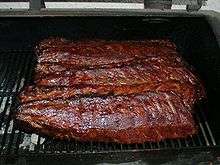Mongolian barbecue
Mongolian barbecue (Chinese: 蒙古烤肉; pinyin: Měnggǔ kǎoròu) is a stir fried dish that was developed by Wu Zhaonan in Taiwan in 1951.[1][2] Meat and vegetables are cooked on large, round, solid iron griddles at temperatures of up to 300 °C (572 °F). Despite its name, the dish is not Mongolian, and is only loosely related to barbecue.[3][4]

Origin

Mongolian barbecue was created by the Taiwanese comedian and restaurateur Wu Zhaonan. A native of Beijing, Wu fled to Taiwan because of the Chinese Civil War, and opened a street food stall in Yingqiao, Taipei in 1951.[1][2] He originally wanted to call the dish "Beijing barbecue", but because of political sensitivity with the city, which had just recently been designated as the capital of Communist China, he settled with "Mongolian barbecue" instead, even though it had no direct connection to Mongolia.[5]
Wu's food stall became very popular and even attracted foreign diplomats and wealthy businesspeople despite being a cheap eatery. However, it was later destroyed by flooding caused by a typhoon, in which Wu nearly drowned.[5] He then developed a highly successful career as a comedian and exited the restaurant business, while numerous imitators emerged to capitalize on the popularity of the dish he created, with Genghis Khan, Tang Palace, Great Khan, and Heavenly Khan among the oldest and most popular.[5] It was later successfully introduced to the West.[3]
Preparation
Typically, diners select a variety of raw ingredients from a display of thinly sliced meats (such as beef, pork, lamb, turkey, chicken, and shrimp) and vegetables (such as cabbage, tofu, onion, broccoli, and mushrooms). The bowl of ingredients is handed to the chef who adds the diner's choice of sauce, then transfers them to the grill.
The round shape of the grill allows two or more chefs to cook food simultaneously, and to cook quickly due to the thinly sliced ingredients, so the food is typically cooked in one revolution of the grill. Oil or water may be added to ease cooking. The ingredients are stir-fried continuously over the high heat and all food remains identifiable and intact.
Some American chains place the food on different parts of the round grill, sometimes in a special wedge shaper. Each dish is stirred in its turn, as the operator walks around the outside of the grill and turns each individual's food in succession.
When cooking is complete, each finished dish is scooped into a bowl and handed to the diner. Many Mongolian barbecue restaurants follow an all-you-can-eat buffet format, and allow multiple visits to the grill.
Jingisukan

In Japan, a similar dish to Mongolian barbecue called Jingisukan (ジンギスカン, "Genghis Khan") is prepared with mutton and cooked on a convex metal skillet. The dish is particularly popular on the northern island of Hokkaidō. The dish is rumored to be so named because in prewar Japan, lamb was widely thought to be the meat of choice among Mongolian soldiers, and the dome-shaped skillet is meant to represent the soldier's helmets that they purportedly used to cook their food.
See also
- Asado
- Bulgogi, a popular Korean stir-fried grill similar to Mongolian barbecue
- Khorkhog, a Mongolian dish referred to as "Mongolian barbecue"
- Korean BBQ refers to a variety of grilled dishes in Korean cuisine
- List of Taiwanese inventions and discoveries
- Saj, a convex griddle used in central, south, and west Asia for cooking bread and meat
- Taiwanese cuisine
- Teppanyaki, a similar Japanese style of cooking
Notes
- Chang, Eddy (2018-11-01). "Ceremony to be held honoring late crosstalk master Wu Zhao-nan". Taipei Times. Retrieved 6 November 2018.
- Chang, Eddy (24 July 2014). "Restaurant review: Genghis Khan Mongolian Bar-B-Q". Taipei Times. Retrieved 6 November 2018.
- Calta, Marialisa (December 14, 1988). "AT THE NATION'S TABLE; Appleton, Wis". The New York Times. Retrieved 2018-11-06.
- Schwabe, Calvin W. (1979). Unmentionable Cuisine. University of Virginia Press. p. 125. ISBN 978-0-8139-1162-5.
- Liang Fengrong 梁峰榮 (13 December 2012). "呷台灣/吳兆南發明的蒙古烤肉 蒙古吃不到". Xin News. Retrieved 2018-11-06.

